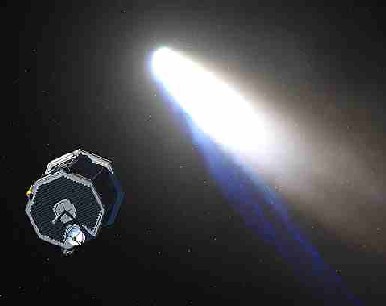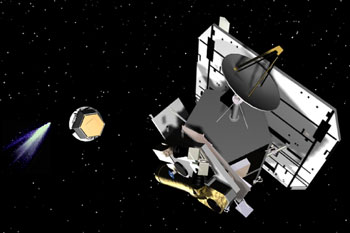CONTOUR
 
This first image shows CONTOUR breezing past a comet nucleus (artist's rendition). The second image is a picture of all of the orbits involved. It shows how CONTOUR will be able to intersect the paths of the three comets.
Images Courtesy of NASA
|
The COmet Nucleus TOUR (CONTOUR) is one of the latest missions to join NASA's Discovery Program, a low cost alternative program. The spacecraft will begin its journey in 2002 and will study comets until 2008. The three targeted comets are Comet Encke, Comet Schwassmann-Wachmann-3 and Comet d'Arrest.
CONTOUR will fly by these comets and take detailed pictures of their nuclei. This type of mission was last performed in the mid-80's with Comet Halley by the European Space Agency (ESA). Scientists say CONTOUR will provide higher quality images than its predecessor. It will also collect comet dust for analysis.
The goal of the mission to learn more about these unique objects. Surprisingly, we know very little about comets. Scientists say that learning more about the make up of comets will help us to better understand the Earth.
|
 CONTOUR mission page
CONTOUR mission page
 Other comet missions
Other comet missions
You might also be interested in:

Six spacecraft flew by Halley's comet in 1986. There were two spacecraft launched from Japan, Suisei and Sakigake, and two from the Soviet Union, Vega 1 & 2. One spacecraft, ICE, from the United States
...more
The Comet Nucleus Tour (CONTOUR), a NASA Discovery Mission, launched July 3, 2002 from Cape Canaveral, Florida. The CONTOUR spacecraft will fly by at least two comets, taking pictures and collecting dust
...more
We are sad to report that the Comet Nucleus Tour (CONTOUR), which launched July 3, 2002, is currently lost in space. The CONTOUR spacecraft was to explore the nucleus of comets. It was scheduled to fly
...more
NASA chose Deep Impact to be part of a special series called the Discovery Program on July 7, 1999. In May 2001, Deep Impact was given the "go" from NASA to start with mission development. Deep Impact
...more
The Cassini probe began its journey to Saturn on October 15, 1997. It flew by Earth in August, 1999, before heading towards the distant planet. Cassini passed Jupiter in 2000 and then burned towards its
...more
The MErcury Surface Space ENvironment, GEochemistry Ranging mission
...more















